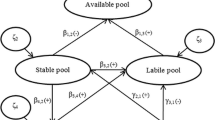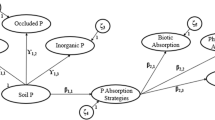Abstract
Respecification of structural models allows evaluating new hypothesis and enhances understanding of how changes in one pool can affect the other pools in the model. The aim of this study was to evaluate the theoretical concept of P pools (unmeasurable variables—latent) using data from Hedley’s sequential extraction method for a better understanding of the P cycle in tropical soils. The theoretical concept being tested is the degree to which available P is controlled by different soil P pools as measured by extraction techniques. The respecified models were adequate and able to represent a generalization of P cycling in soils. The best structural model including latent variables with multiple indicators was consistent with the theoretical concept that the indicators of soil P pools are P fractions determined by the sequential extraction method. In this model, not only is there a direct relationship between the organic, occluded and primary mineral pools and the available P pool, but the indirect relationships via the organic pool were theoretically and statistically adequate. Thus, the model showed the interrelationships of geochemical and biological processes on the available P and it corroborated the hypothesis of the dependence of the available P pool to the organic pool in unfertilized tropical soils.








Similar content being viewed by others
References
Araújo MSB, Schaefer CEGR, Sampaio EVSB (2004) Soil phosphorus fractions from toposequences of semi-arid Latosols and Luvisols in northestern Brazil. Geoderma 119:309–321
Beck MA, Sanchez PA (1994) Soil phosphorus fraction dynamics during 18 years of cultivation on a Typic Paleudult. Soil Sci Soc Am J 58:1424–1430
Bollen KA (1989) Structural equation with latent variables. Wiley, New York, p 514
Bollen KA, Noble MD (2011) Structural equation models and the quantification of behavior. Proc Natl Acad Sci 108:15639–15646
Cross AF, Schlesinger WH (1995) A literature review and evaluation of the Hedley fractionation: application to the biogeochemical cycle of soil phosphorus in natural ecosystems. Geoderma 64:197–214
Dieter D, Elsenbeer H, Turner B (2010) Phosphorus fractionation in lowland tropical rainforest soils in central Panama. Catena 82:118–125
Gama-Rodrigues AC, Sales MVS, Silva PSD, Comerford NB, Cropper WP, Gama-Rodrigues EF (2014) An exploratory analysis of phosphorus transformations in tropical soils using structural equation modeling. Biogeochemistry 118:453–469
Gijsman AJ, Oberson A, Tiessen H, Friesen DK (1996) Limited applicability of the CENTURY model to highly weathered tropical soils. Agron J 88:894–903
Grace JB, Bollen KA (2008) Representing general theoretical concepts in structural equation models: the role of composite variables. Environ Ecol Stat 15:191–213
Grace JB, Anderson TM, Olff H, Scheiner SM (2010) On the specification of structural equation models for ecological systems. Ecol Monogr 80:67–87
Grace JB, Schoolmaster DR, Guntenspergen GR, Little AM, Mitchell BR, Miller KM, Schweiger EW (2012) Guidelines for a graph-theoretic implementation of structural equation modeling. Ecosphere 3:1–44
Guppy CN, Menzies NW, Moody PW, Blamey FPC (2005) Competitive sorption reactions between phosphorus and organic matter in soil: a review. Aust J Soil 43:189–202
Hair JF, Black WC, Babin BJ, Anderson E, Tathan RL (2009) Multivariate data analysis. Prentice-Hall Inc, Upper Saddle River, p 688
He Z, Fortuna AM, Senwo ZN, Tazisong IA, Honeycutt CW, Griffin TS (2006) Hydrochloric fractions in Hedley fractionation may contain inorganic and organic phosphates. Soil Sci Soc Am J 70:893–899
Hedley MJ, Stewart WB, Chauhan BS (1982) Changes in inorganic and organic soil phosphorus fractions induced by cultivation practices and by laboratory incubations. Soil Sci Soc Am J 46:970–976
Lambers H, Raven JA, Shaver GR, Smith S (2008) Plant nutrient-acquisition strategies change with soil age. Trends Ecol Evol 23:95–103
Marklein AR, Houlton BZ (2012) Nitrogen inputs accelerate phosphorus cycling rates across a wide variety of terrestrial ecosystems. New Phytol 193:696–704
McGill WB, Cole CV (1981) Comparative aspects of cycling of organic C, N, S, and P through soil organic matter. Geoderma 26:267–286
Mitchell RJ (1992) Testing evolutionary and ecological hypotheses using path analysis and structural equation modeling. Funct Ecol 6:123–129
Nasto MK, Alvarez-Clare S, Lekberg Y, Sullivan BW, Townsend AR, Cleveland CC (2014) Interactions among nitrogen fixation and phosphorus acquisition strategies in lowland tropical rain forests. Ecol Lett 17:1282–1289
Oberson A, Friesen DK, Rao IM, Bühler S, Frossard E (2001) Phosphorus transformations in an Oxisol under contrasting land use systems: role of the soil microbial biomass. Plant Soil 237:197–210
Pugesek BH, Tomer A, Eye A (2003) Structural equation modeling: applications in ecological and evolutionary biology. Cambridge University Press, New York, p 409
Reed SC, Townsend AR, Taylor PG, Cleveland CC (2011) Phosphorus cycling in tropical forests growing on highly weathered soils. In: Bünemann EK, Oberson A, Frossard E (eds) Phosphorus in action: biological processes in soil phosphorus cycling. Springer, Berlin, pp 339–369
Richardson AE, Lynch JP, Ryan PR, Delhaize E, Smith FA, Smith SE, Harvey PR, Ryan MH, Veneklaas EJ, Lambers H, Oberson A, Culvenor RA, Simpson RJ (2011) Plant and microbial strategies to improve the phosphorus efficiency of agriculture. Plant Soil 349:121–156
Sato S, Comerford NB (2006) Organic anions and phosphorus desorption and bioavailabilty in a humid Brazilian Ultisol. Soil Sci 171:695–705
Tiessen H, Moir JO (1993) Characterisation of available P by sequential extraction. In: Carter MR (ed) Soil sampling and methods of soil analysis. CRC Press, Boca Raton, pp 75–86
Tiessen H, Stewart WB, Cole CV (1984) Pathways of phosphorus transformation in soils of differing pedogenesis. Soil Sci Soc Am J 48:853–858
Turner BL (2008) Resource partitioning for soil phosphorus: a hypothesis. J Ecol 96:698–702
Turner BL, Wells A, Condron LM (2014) Soil organic phosphorus transformations along a coastal dune chronosequence under New Zealand temperate rain forest. Biogeochemistry 121:595–611
Vitousek PM, Porder S, Houlton BZ, Chadwick OA (2010) Terrestrial phosphorus limitation: mechanisms, implications, and nitrogen-phosphorus interactions. Ecol Appl 20:5–15
Wang YP, Houlton BZ, Field CB (2007) A model of biogeochemical cycles of carbon, nitrogen, and phosphorus including symbiotic nitrogen fixation and phosphatase production. Glob Biogeochem Cycles 21: GB1018. doi: 10.1029/2006GB002797
Zheng Z, Simard RR, Lafond J, Parent LE (2002) Pathways of soil phosphorus transformations after 8 years of cultivation under contrasting cropping practices. Soil Sci Soc Am J 66:999–1007
Author information
Authors and Affiliations
Corresponding author
Rights and permissions
About this article
Cite this article
Sales, M.V.S., Gama-Rodrigues, A.C., Comerford, N.B. et al. Respecification of structural equation models for the P cycle in tropical soils. Nutr Cycl Agroecosyst 102, 347–358 (2015). https://doi.org/10.1007/s10705-015-9706-5
Received:
Accepted:
Published:
Issue Date:
DOI: https://doi.org/10.1007/s10705-015-9706-5




